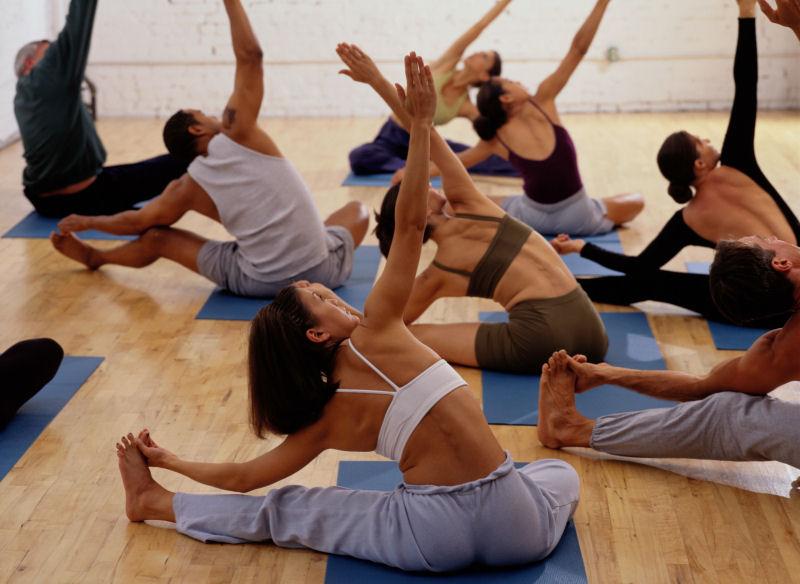 |
 |
 When you decide to make some positive health choices in your life,
rather than focus on things you don't like and want to change, why not
focus on incorporating more of what you actually want to experience?
Include positive statements like "I choose" and "I will" rather than
negative statements like "I'll quit" or "I won't." You can turn any
thought or statement into a positive affirmation of what you want to
include in life. Here is an example of how you can turn even the most
negative of thoughts into a positive New Year's resolution. When you decide to make some positive health choices in your life,
rather than focus on things you don't like and want to change, why not
focus on incorporating more of what you actually want to experience?
Include positive statements like "I choose" and "I will" rather than
negative statements like "I'll quit" or "I won't." You can turn any
thought or statement into a positive affirmation of what you want to
include in life. Here is an example of how you can turn even the most
negative of thoughts into a positive New Year's resolution.
Let's
start
with a less than enlightened sentiment: "I'm always stressed
out"; "I'm fat, and I can't get it together to lose weight"
Find a way
to make a statement of choice, rather than fact: "I choose to find ways
to be less stressed"; "I choose to achieve my weight goals"
Now, take out the trigger words: "I choose to have a calm and relaxed demeanor"; "I choose improved health for my body"
Include
a course of action to achieve these goals: "I choose to be calm and
relaxed by using my meditation and breathing techniques"; "I choose
improved health for my body through a healthful diet and enjoyable
exercise"
Finally, stop separating yourself from these goals: "I
am calm and relaxed, using meditation and breathing techniques to
maintain my calm." "My health is improving as I eat a healthful diet and
get appropriate and enjoyable exercise."
|
|
 |
 |
|

We've
all familiar with the imagery of the serene yogi meditating his way to
enlightenment. You don't need to sit atop a mountain or spend weeks in
a cave to benefit from a meditation practice. In fact, all you need is
a quiet space and a few moments to yourself. While meditation can be
done anytime or anywhere, it can be very helpful to have a dedicated
space in your home.
When you create this space, look for
someplace outside of the usual traffic flow of your home- you don't
want people walking through while you are meditating. A space with
natural light is the most desirable. If this is not possible, look
into lamps and candles that can provide soft light. Fresh air flow is
wonderful if you live someplace where a window can be opened without
letting in much outside noise.
Look to your own comfort. Seated
meditation can take place in a chair or on a folded blanket or mat on
the floor. Know your own body- if sitting on the floor without back
support is going to cause you to be uncomfortable, sit in a chair, or
place a pillow or mat where you can lean against something for
support. If sitting upright, unsupported, is your goal, work up to
that, but don't forgo a deep meditative experience because your ego
doesn't want to admit that you can't yet sit perfectly still on the
floor for twenty minutes.
Have a blanket available, in case you
become chilled during your meditation. If you enjoy candles or
incense, you might choose to incorporate those into your space.
Likewise, sacred or special images or objects are also a good idea,
although, in general, the less clutter in the space, the better.
Whenever
you enter your meditation space, make sure that you have turned off
your phone, pager, or anything else that might disrupt you. If you
have a limited amount of time, you can set a timer, choosing one that
will have a pleasing, quiet noise when it goes off. The last thing you
want is to be ripped out of your meditative space by loud and obnoxious
beeping. Try to find a time in your schedule each day to spend twenty
minutes or so in your meditation space. If possible, do not multitask
in this space, rather, keep it devoted to your meditation practice.
|
|
 |
 |
| By Nicole Nichols, Fitness Instructor & Health Educator |
 Winter is in full force. As the days get shorter and the nights get
colder, even the best of us can get a little down. The "winter blues"
are characterized by the mild depression, lack of motivation, and low
energy that many people experience during this cold season. Luckily,
there’s a lot you can do to both prevent the blues from coming on, and
get yourself back to normal if they’re already here. Winter is in full force. As the days get shorter and the nights get
colder, even the best of us can get a little down. The "winter blues"
are characterized by the mild depression, lack of motivation, and low
energy that many people experience during this cold season. Luckily,
there’s a lot you can do to both prevent the blues from coming on, and
get yourself back to normal if they’re already here.
- Exercise
As if we needed another reason to get
fit! Exercise isn’t only for maintaining your weight and staying
healthy. It’s great for relieving the stresses of life. Plus, the
effects of a good workout can last for several hours after you hit the
showers. You’ll have more energy throughout the day, and your
metabolism with stay elevated too. Exercise also helps your mind by
releasing those "feel good chemicals" that improve your mood.
- Eat a Healthy Diet
What
and when you eat has a great affect on your mood and energy. Avoid
refined and processed foods (like white breads, rice, and sugar). These
foods are not only devoid of the nutrients your body craves, but they
zap your energy levels and can affect your mood—causing depression,
lack of concentration, and mood swings. Try to incorporate more complex
carbohydrates (whole wheat breads, brown rice, veggies, fruit) and get
your daily 8 cups of water. These healthy foods provide your body (and
mind) with nutrients, and stabilize your blood sugar and your energy
levels.
- Get Some Sun
Most people know that
sunlight provides us with Vitamin D. But did you know that it also
improves your mood? Winter days are shorter and darker than other
months, and because of the cold weather, a lot of people spend less and
less time outdoors. Lack of sunlight can cause many people to become
depressed—without knowing why! Similar to exercise, sunlight exposure
releases neurotransmitters in the brain that affect mood. Try to spend
a little more time outdoors. Keep your shades up during the day to let
more light in. Sit near windows in restaurants and during class. Try
changing the light bulbs in your house to "full spectrum" bulbs. These
mimic natural light and actually have the same affects on your mind as
the real thing.
- Act on your Resolutions
A
recent study from the CDC showed a strong link between healthy
behaviors and depression. Women who exhibited healthy behaviors (like
exercising, not smoking, etc.) had less sad and depressed days than
those whose behaviors were less than healthy. Although researchers
studied women, the results are likely similar in men.
- Avoid Binge Drinking
Staying
in with a cold beer or a nice glass of wine may seem like the only
thing to do in the winter months, and many people who feel down also
tend to turn to alcohol when they’re feeling down. But alcohol is
actually a depressant, and rather than improving your mood, it only
makes it worse. Avoiding alcohol when you are already depressed is a
good idea. Moderate drinking is fine for most people, but binge
drinking (defined as having 5 or more drinks in one sitting) is never a
healthy choice. The morning after will have you feeling sick,
depressed, and even more tired, which will affect many aspects of your
life. This will make your low energy and bad mood even worse.
- Treat Yourself
Having
something to look forward to can keep anyone motivated. Winter seems
endless! But if you plan something exciting, your mood improves when
you’re anticipating it and when the event actually comes. Plan
something that’s exciting to you—a weekend trip, a day at the spa, a
party (but keep #5 above in mind), or special event like a play, girls
(or guys) night out, or sporting event.
- Relax!
You’re
busy! Work, class, family, friends, appointments, meetings—even if you
enjoy being busy, everyone needs some time off. Don’t be afraid to say
"No" to extra opportunities (covering a shift for a co-worker, bringing
food to your son’s class party). Try to spend a few minutes each day
doing nothing! Read a book or magazine, sleep in on the weekend, go to
bed early, try some meditations, or take a yoga class. Relaxation,
especially in the form of yoga, can alleviate stress and leave you with
a calm energy. Mental exercises, like meditation and positive thinking,
can help keep depression at bay.
- Embrace the Season
Instead
of always avoiding the cold and the snow—look for the best that it has
to offer! Take up a winter sport like ice skating, snowboarding,
hockey, or even sledding! Enjoy these opportunities while they
last—after all, they’re only here a few months per year. Staying active
will boost your energy. Seeing winter in a positive light, with all the
fun activities that it has to offer, will keep your spirits high.
- Get Social Support
Don’t
underestimate the power of friends, family, mentors, co-workers, and
neighbors. Who can you turn to when you’re down and need a pick-me-up?
Keep a mental list of these special people and don’t be afraid to ask
for help or encouragement when you need it. Something as simple as a
phone call, a chat over coffee, or a nice email or letter can brighten
your mood.
- Catch some Zzzz’s
People
naturally want to sleep a little bit more during the winter. But with
all we have going on, sometimes sleep is the first thing to go. With a
little time management, and some self-discipline, you can meet your
shut-eye needs. Aim for 7-8 hours each night, and try to keep your
bedtime and waking time consistent. That way, your sleeping patterns
can normalize and you’ll have more energy. Try not to oversleep—those
12-hour snoozes on the weekend can actually make you MORE tired. Don’t
forget naps! A short (10-30 minute) afternoon nap may be all you need
to re-energize midday.
|
|
 |
 |
 Laughter
is the newest weapon in our fight against heart disease. It
was noted in a study that healthy people laugh more often
and use laughter or humor to get them out of bad situations. A
good laugh can go a long way in reducing pain. It may help a person who
has had a heart attack. A study on this showed that rehabilitation was
much more effective for patients who watched funny videos each day than
ones who did not. Laughter has been so effective in the recovery of
illnesses that hospitals have created rooms dedicated to humor and have
installed cable TV with comedy channels in patient rooms. Laughter
is the newest weapon in our fight against heart disease. It
was noted in a study that healthy people laugh more often
and use laughter or humor to get them out of bad situations. A
good laugh can go a long way in reducing pain. It may help a person who
has had a heart attack. A study on this showed that rehabilitation was
much more effective for patients who watched funny videos each day than
ones who did not. Laughter has been so effective in the recovery of
illnesses that hospitals have created rooms dedicated to humor and have
installed cable TV with comedy channels in patient rooms.
The medical researchers found that laughter can lower blood pressure, which
helps reduce stress hormones, and gives a charge to the immune
system, as well as many other functions of our body. Laughter also releases our
body's natural painkillers and gives us an overall sense of feeling
good. Research shows that laughing fifteen minutes each day could
prolong your life. This comes from stimulating the blood flow and
helping your heart. Laughter has similar health benefits as aerobic
exercise, but comes without the aches and pains. Laughter is a good
medicine - even the expectation of laughter showed to be very effective.
The
same research showed that a person expecting to watch a funny program
or video
lowered their stress inducing chemicals, which helped release stress
relievers. Brain chemistry seems to be changed by laughter; being able
to laugh seems to give a person more control over themselves as well as
over the situation. Have you ever thought that a good belly laugh could
be like a trip to the spa for your upper body? When you laugh, you
stretch many of the upper body muscles, these muscles relax and unknot,
even your abdomen and diaphragms contract. This brings aa thought to
mind. If laughter can help patients in a cardiac rehabilitation
program, why not add it to the program? Adding laughter to a program
should be a simple enough task.
Adding laughter to a program should be a simple enough task and just as important as what patients eat and the exercise they
take. Laughter can be a safety valve for us. A pressure cooker has a
safety valve, and if the steam gets to be too much, it blows. The same is true
with our hearts, so a good laugh on a regular basis could help regulate
out heart. If heart disease is directly related to the body’s ability
to cope with stress, anger, and all the hormones produced as a result
of those emotions, then it should stand to reason, that the counter
effect of stress and anger would be laughter.
The opposite effect should be felt on our bodies, even our hearts,
blood vessels, and other bodily functions. So, the next time you begin
to feel those "raging" hormones being released, stop. Find a funny
picture, watch a funny video, or just watch your children at play.
Humor will find its way into your emotions and, rather than experience
a heart attack, you might find yourself experiencing a laugh attack.
Not
only will your heart thank you, but so will your family and co-workers!
Read the full article here.
|
|
 |
| Include your contact information below |
#my_firstname# #my_lastname#
#my_phone#
|
|
|
 |
|
In This Issue:
|
|
 |
|
Updates
|
|
Include
your updates here. This information can change month
to month or remain static.
#my_firstname# #my_lastname#
#my_phone#
|

|
|
Featured Spirit Cards
|
|


To view more free spirit ecards, click
here.
|

|
|
Wheat Berry Salad with Apples and Mint
|
|
Serves 4 to 6
Chewy wheat berries develop a juicy “squish” when marinated briefly
in dressing. A citrus dressing is a particularly good complement to the
tart green apple and vibrant mint tossed into the mix.

The salad tastes best when freshly made; the wheat berries tend to
harden when refrigerated. To improve the texture of any leftovers,
loosely cover the salad with waxed paper, and microwave it for about 20
seconds. Perk up the taste with a little lemon juice.
Serve the salad at room temperature, on its own, or with roast chicken or grilled meat.
Ingredients
1/2 cup orange juice
2 tablespoons olive oil
1 1/2 tablespoons apple cider vinegar
1 teaspoon salt, plus more to taste
3/4 cup tightly packed mint leaves
2 cups cooked wheat berries
2 teaspoons grated orange zest (from 2 juice oranges)
1 small green apple
1 small red apple
1/2 cup hazelnuts, toasted and coarsely chopped
Instructions
First prepare the dressing: Blend the orange juice, oil, vinegar, salt, and 1/2 cup of the mint in a food processor or blender.
Set the wheat berries in a medium bowl. Pour the dressing over them
and toss to coat. Stir in the orange zest. Set aside for at least 15
minutes. Toss occasionally.
Meanwhile, core the apples and cut them into 1/4-inch dice. Stack
the remaining mint leaves and roll them into a log. Slice them as
thinly as you can. Toss them into the salad along with the apple, and
hazelnuts. Add more salt, if needed.
Variations
After blending the dressing, stir in 2 to 3 tablespoons finely chopped crystallized ginger.
Grain Exchange
Use triticale, spelt, or kamut instead of wheatberries.
|

|
|
Tips for Healthy Skin and Hair
|
|

The winter months can be harsh on skin and hair, especially for those
of us in a dry environment. In order to keep skin and hair looking its
best, staying hydrated is the very best thing that you can do.
Prevention is the best approach- rather than waiting until your skin is
try and cracked, or your hair is frizzy and fly-away, take the approach
of never letting it get that way. Make sure that you're getting those
eight glasses a water each day, even if you also eat foods high in
water content.
Start by using moisturizing products. Even if
you have oily hair, using conditioner on the lower ends of your hair
will help keep dryness at bay. After you shower, apply a natural oil,
such as grapeseed or jojoba, to your skin. If you experience severe
dry skin, try rubbing a few drops of sweet almond oil into the troubled
area. You can also use small amounts of lighter oil, such as the
jojoba or grapeseed, on your hair to enhance shine and add moisture.

|
|
 |